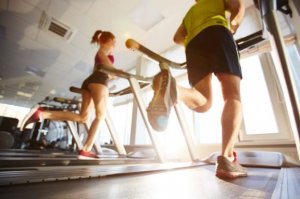Running on the Treadmill Accelerates Your Metabolism and Burns More Calories

After a weight lifting session, the cardio phase begins. When we are following a fat loss plan, we should work out five times a week for 45 minutes per session. It’s a good idea to run on the treadmill. Running on the treadmill accelerates your metabolism and burns more calories.
Of course, in order to achieve good results, you’ll need perseverance and discipline. A good nutrition plan and a well planned routine will make your workout fun and help you to meet your goals.
Among the advantages of this machine is that we can find it in every gym. However, it’s not enough to just run on it every day with the same intensity. To optimize your results you need to know how to train on it.
Running on the treadmill when you are a beginner
If you haven’t been training for very long, three to five miles is the right distance to start with. In a few weeks, your body will increase its endurance and you’ll be able to run seven to eight miles.

In the beginning, it’s advisable to keep your sessions to under 45 minutes. You can gradually increase your workouts. Twenty-five minutes is a good starting point from where you can boost your resistance and strength slowly.
On the other hand, you need to pay special attention to your position while running. Keeping your posture straight and swinging your arms will make you an expert. Balance involves a greater amount of muscles.
Tips to improve performance
On occasions, people feel disappointed when they don’t feel they have achieved the results they expected in a matter of weeks. Actually, certain essential aspects may be missing in the plan, among these are nutrition and the way they are working out.
In order to achieve a greater weight loss, it’s necessary to vary your workout routine. This is why we recommend that you do not let your body become used to the same exercises. Running similar distances and intensities every day is not recommendable. In the beginning, you’ll see significant progress but then your body will not be making a strong effort.
A good method is to workout in intervals. This method consists of programming the machine to mix the hike with a high intensity run. You can walk 60 seconds, run 40 seconds and alternate subsequently.
However, this interval method cannot be performed every day. It’s recommended to practice this for no more than three times a week. The other two days you can jog at a moderate intensity.
Running outdoors versus the treadmill
Truly, when you run outdoors you can burn more calories than on a slow and repetitive treadmill. However, when functions as inclination and speed are used, the outcome may be different.
On the other hand, there is the argument that running in summer can make us burn fat more efficiently. Although this may be true, the effects may be devastating if you do not hydrate properly.
In practice, increasing your body’s thermodynamics is necessary in order to lose weight. This must be clear, we must avoid adverse conditions when we accelerate our metabolisms.

Can you run on the treadmill wearing weights?
The answer to this question is very simple. If you’re on a weight loss plan, wearing weights on your ankles is not recommended. Do your strength exercises before your cardio.
On the contrary, if you want to wear weights on the treadmill you may do it if you are looking to tone up your muscles. We may also resort to these techniques when we do not have enough time to do anaerobic exercises.
How to measure your results on the treadmill?
Many times people believe that weight loss is the best way to know if you’re becoming thinner. However this isn’t entirely true. The pounds lost or gained may be used as a reference, but are unreliable in some cases.
With a good nutrition plan and the right exercise, you burn fat but also gain muscle. Therefore, it’s recommended you use a tape measure. This will tell you how many inches you have lost. Careful! Using a tape measure once a month is more than enough.
After a weight lifting session, the cardio phase begins. When we are following a fat loss plan, we should work out five times a week for 45 minutes per session. It’s a good idea to run on the treadmill. Running on the treadmill accelerates your metabolism and burns more calories.
Of course, in order to achieve good results, you’ll need perseverance and discipline. A good nutrition plan and a well planned routine will make your workout fun and help you to meet your goals.
Among the advantages of this machine is that we can find it in every gym. However, it’s not enough to just run on it every day with the same intensity. To optimize your results you need to know how to train on it.
Running on the treadmill when you are a beginner
If you haven’t been training for very long, three to five miles is the right distance to start with. In a few weeks, your body will increase its endurance and you’ll be able to run seven to eight miles.

In the beginning, it’s advisable to keep your sessions to under 45 minutes. You can gradually increase your workouts. Twenty-five minutes is a good starting point from where you can boost your resistance and strength slowly.
On the other hand, you need to pay special attention to your position while running. Keeping your posture straight and swinging your arms will make you an expert. Balance involves a greater amount of muscles.
Tips to improve performance
On occasions, people feel disappointed when they don’t feel they have achieved the results they expected in a matter of weeks. Actually, certain essential aspects may be missing in the plan, among these are nutrition and the way they are working out.
In order to achieve a greater weight loss, it’s necessary to vary your workout routine. This is why we recommend that you do not let your body become used to the same exercises. Running similar distances and intensities every day is not recommendable. In the beginning, you’ll see significant progress but then your body will not be making a strong effort.
A good method is to workout in intervals. This method consists of programming the machine to mix the hike with a high intensity run. You can walk 60 seconds, run 40 seconds and alternate subsequently.
However, this interval method cannot be performed every day. It’s recommended to practice this for no more than three times a week. The other two days you can jog at a moderate intensity.
Running outdoors versus the treadmill
Truly, when you run outdoors you can burn more calories than on a slow and repetitive treadmill. However, when functions as inclination and speed are used, the outcome may be different.
On the other hand, there is the argument that running in summer can make us burn fat more efficiently. Although this may be true, the effects may be devastating if you do not hydrate properly.
In practice, increasing your body’s thermodynamics is necessary in order to lose weight. This must be clear, we must avoid adverse conditions when we accelerate our metabolisms.

Can you run on the treadmill wearing weights?
The answer to this question is very simple. If you’re on a weight loss plan, wearing weights on your ankles is not recommended. Do your strength exercises before your cardio.
On the contrary, if you want to wear weights on the treadmill you may do it if you are looking to tone up your muscles. We may also resort to these techniques when we do not have enough time to do anaerobic exercises.
How to measure your results on the treadmill?
Many times people believe that weight loss is the best way to know if you’re becoming thinner. However this isn’t entirely true. The pounds lost or gained may be used as a reference, but are unreliable in some cases.
With a good nutrition plan and the right exercise, you burn fat but also gain muscle. Therefore, it’s recommended you use a tape measure. This will tell you how many inches you have lost. Careful! Using a tape measure once a month is more than enough.
All cited sources were thoroughly reviewed by our team to ensure their quality, reliability, currency, and validity. The bibliography of this article was considered reliable and of academic or scientific accuracy.
- Riley, P. O., Dicharry, J., Franz, J., Croce, U. Della, Wilder, R. P., & Kerrigan, D. C. (2008). A kinematics and kinetic comparison of overground and treadmill running. Medicine and Science in Sports and Exercise. https://doi.org/10.1249/MSS.0b013e3181677530
- Jones, A. M., & Doust, J. H. (1996). A 1% treadmill grade most accurately reflects the energetic cost of outdoor running. Journal of Sports Sciences. https://doi.org/10.1080/02640419608727717
- Paavolainen, L., Häkkinen, K., Hämäläinen, I., Nummela, A., & Rusko, H. (1999). Explosive-strength training improves 5-km running time by improving running economy and muscle power. Journal of Applied Physiology (Bethesda, Md. : 1985). https://doi.org/10.1034/j.1600-0838.2003.00340.x
- García-Pérez, J. A., Pérez-Soriano, P., Llana Belloch, S., Lucas-Cuevas, Á. G., & Sánchez-Zuriaga, D. (2014). Effects of treadmill running and fatigue on impact acceleration in distance running. Sports Biomechanics. https://doi.org/10.1080/14763141.2014.909527
This text is provided for informational purposes only and does not replace consultation with a professional. If in doubt, consult your specialist.








